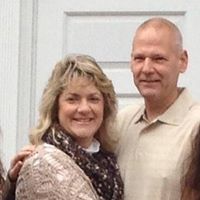Amy L Cowperthwait
age ~59
from Bear, DE
- Also known as:
-
- Amy Lynn Atkinson
- Amy L Atkinson
- Amy L Cowperthwa
- Adam C Cowperthwait
- Amy Cowperthwaite
- Amy T
- Amy Cowpertwait
- Phone and address:
-
110 Grove Mansion Way, Bear, DE 19701
3025954533
Amy Cowperthwait Phones & Addresses
- 110 Grove Mansion Way, Bear, DE 19701 • 3025954533
- State College, PA
- Pennsville, NJ
- 27 Christina Woods Ct, Newark, DE 19702 • 3027371226
- Delaware City, DE
- New Castle, DE
- 110 Grove Mansion Way, Bear, DE 19701 • 3022367512
Work
-
Company:AvkinJan 2015
-
Position:Founder and chief executive officer | patient-centered simulation training authority | 2016 hayden vanguard recipient
Education
-
Degree:Master of Science, Masters, Master of Science In Nursing
-
School / High School:University of Delaware2007 to 2010
-
Specialities:Nursing, Clinical Nurse
Skills
Public Speaking • Bls • Nursing • Clinical Research • Research • Teaching • Higher Education • Patient Safety • Program Development • Critical Care • Acls • Microsoft Office • Healthcare • Health Education • Healthcare Information Technology • Basic Life Support
Ranks
-
Certificate:Registered Nurse - Delaware
Industries
Higher Education
Resumes

Founder And Chief Executive Officer | Patient-Centered Simulation Training Authority | 2016 Hayden Vanguard Recipient
view sourceLocation:
Wilmington, DE
Industry:
Higher Education
Work:
Avkin
Founder and Chief Executive Officer | Patient-Centered Simulation Training Authority | 2016 Hayden Vanguard Recipient
University of Delaware
Associate Instructor | Co-Founder Healthcare Theatre | Simulation Resource Center Coordinator
Founder and Chief Executive Officer | Patient-Centered Simulation Training Authority | 2016 Hayden Vanguard Recipient
University of Delaware
Associate Instructor | Co-Founder Healthcare Theatre | Simulation Resource Center Coordinator
Education:
University of Delaware 2007 - 2010
Master of Science, Masters, Master of Science In Nursing, Nursing, Clinical Nurse University of Delaware 1983 - 1987
Bachelors, Bachelor of Science, Nursing Mt Pleasant High School 1981 - 1983
Mount Pleasant High School
Master of Science, Masters, Master of Science In Nursing, Nursing, Clinical Nurse University of Delaware 1983 - 1987
Bachelors, Bachelor of Science, Nursing Mt Pleasant High School 1981 - 1983
Mount Pleasant High School
Skills:
Public Speaking
Bls
Nursing
Clinical Research
Research
Teaching
Higher Education
Patient Safety
Program Development
Critical Care
Acls
Microsoft Office
Healthcare
Health Education
Healthcare Information Technology
Basic Life Support
Bls
Nursing
Clinical Research
Research
Teaching
Higher Education
Patient Safety
Program Development
Critical Care
Acls
Microsoft Office
Healthcare
Health Education
Healthcare Information Technology
Basic Life Support
Certifications:
Registered Nurse - Delaware
Clinical Nurse Specialist - Adult Health, Delaware
Clinical Nurse Specialist - Adult Health, Delaware
License Records
Amy Cowperthwait
Address:
Bear, DE
License #:
26NR06996500 - Expired
Category:
Nursing
Issued Date:
Feb 28, 1989
Expiration Date:
May 31, 2002
Type:
Registered Prof. Nurse
Amy Cowperthwait
Address:
Bear, DE
License #:
26NR06996500 - Expired
Category:
Nursing
Issued Date:
Feb 28, 1989
Expiration Date:
May 31, 2002
Type:
Registered Prof. Nurse
Us Patents
-
Medical Treatment Simulation Devices
view source -
US Patent:20200118464, Apr 16, 2020
-
Filed:Nov 25, 2019
-
Appl. No.:16/693833
-
Inventors:Amy COWPERTHWAIT - Newark DE, US
Andrew DEVENNY - Virginia Beach VA, US
Danielle GERSTMAN - Chalfont PA, US -
Assignee:University of Delaware - Newark DE
-
International Classification:G09B 23/28
G09B 23/30 -
Abstract:Medical treatment simulation systems and devices are disclosed. One device includes an overlay, a simulated treatment structure, at least one feedback device, and at least one processor. The overlay is configured to be secured to the live subject and to cover at least a portion of a body of the live subject. The simulated treatment structure is configured to simulate a structure associated with the medical procedure. The at least one feedback device is configured to provide a feedback signal to the live subject. The at least one processor is connected to the simulated treatment structure and the at least one feedback device. The processor is programmed to to operate the feedback device to provide the feedback signal based upon input generated from interaction between a treatment provider and the simulated treatment structure. The disclosed devices may be used to simulate intravenous, catheter, defibrillation, and/or thoracic treatments.
-
Medical Treatment Simulation Devices
view source -
US Patent:20170372639, Dec 28, 2017
-
Filed:Nov 16, 2015
-
Appl. No.:15/527173
-
Inventors:Amy COWPERTHWAIT - Newark DE, US
Amy BUCHA - Newark DE, US
Bimal AMIN - Wilmington DE, US
Jonathan BATHGATE - West Warwick RI, US
Joseph BIGGS - Newark DE, US
Devon BOND - Newark DE, US
Taylor BOYLE - Chicago IL, US
Jennifer BUCKLEY - Newark DE, US
Dominic CAMPAGNOLA - Newark DE, US
Aidan COOPER - Merrick NY, US
Andrew DEVENNY - Virginia Beach VA, US
Edward DOLL - Newark DE, US
Matthew ELIZARDO - Newark DE, US
Lindsay EVANS - West Chester PA, US
Brittany FAY - Newark DE, US
Danielle GERSTMAN - Chalfont PA, US
Kenneth GOYDAN - Bridgewater NJ, US
Wyatt GRANT - Newark DE, US
Nathan HOTT - Newark DE, US
Thomas MCDOWELL - Pittsburgh PA, US
Elizabeth RACCA - Newark DE, US
Francis RIVERA - Elkton MD, US
Liyun WANG - Newark DE, US -
Assignee:University of Delaware - Newark DE
-
International Classification:G09B 23/28
G09B 23/30 -
Abstract:Medical treatment simulation systems and devices are disclosed. One device includes an overlay, a simulated treatment structure, at least one feedback device, and at least one processor. The overlay is configured to be secured to the live subject and to cover at least a portion of a body of the live subject. The simulated treatment structure is configured to simulate a structure associated with the medical procedure. The at least one feedback device is configured to provide a feedback signal to the live subject. The at least one processor is connected to the simulated treatment structure and the at least one feedback device. The processor is programmed to operate the feedback device to provide the feedback signal based upon input generated from interaction between a treatment provider and the simulated treatment structure. The disclosed devices may be used to simulate intravenous, catheter, defibrillation, and/or thoracic treatments.
-
Medical Treatment Simulation Devices
view source -
US Patent:20170323586, Nov 9, 2017
-
Filed:Jul 27, 2017
-
Appl. No.:15/661529
-
Inventors:Amy Cowperthwait - Bear DE, US
Joseph Biggs - Middletown DE, US
Dominic Campagnola - Newark DE, US
Devon Bond - Chadds Ford PA, US
Edward Doll - Baltimore MD, US
Nathan Hott - Great Falls VA, US
Francis Rivera - Elkton MD, US
Jenni Buckley - Newark DE, US
Liyun Wang - Newark DE, US -
Assignee:University of Delaware - Newark DE
-
International Classification:G09B 23/28
-
Abstract:Medical treatment simulation devices are disclosed. One device includes an overlay configured to be secured to a subject, a simulated treatment structure, at least one detector, and at least one feedback device. The detector is coupled to the simulated treatment structure and configured to detect an interaction with the simulated treatment structure. The feedback device is coupled to the overlay and configured to provide feedback based on the interaction detected by the at least one detector.
-
Medical Treatment Simulation Devices
view source -
US Patent:20150056592, Feb 26, 2015
-
Filed:Aug 22, 2014
-
Appl. No.:14/466027
-
Inventors:Amy Cowperthwait - Bear DE, US
-
Assignee:University of Delaware - Newark DE
-
International Classification:G09B 23/28
G09B 5/02 -
US Classification:434265
-
Abstract:Medical treatment simulation devices are disclosed. One device includes an overlay, a tracheostomy structure, one or more tubes, at least one sensor, and at least one feedback device. The overlay is configured to be secured to a subject. The overlay is configured to cover at least a portion of a neck and upper torso of the subject. The tracheostomy structure is provided in a neck portion of the overlay. The one or more tubes are positioned within the overlay. The tubes are connected to the tracheostomy structure. The sensor is coupled to the tracheostomy structure and configured to detect a manipulation of the tracheostomy structure. The feedback device is coupled to the overlay. The feedback device is configured to provide feedback based on the manipulation detected by the at least one sensor.
Classmates

Amy Cowperthwait
view sourceSchools:
Prairie Vancouver WA 1997-2001
Community:
Scott Warren, Andrew Sarvinski

Amy Cowperthwait (Atkinson)
view sourceSchools:
Mt. Pleasant High School Wilmington DE 1979-1983

Prairie High School, Brus...
view sourceGraduates:
Amy Cowperthwait (1997-2001),
Deborah Morey (1989-1993)
Deborah Morey (1989-1993)
Youtube

Amy Cowperthwait
view source
Amy Cowperthwait
view sourceAmy Cowperthwait ada di Facebook. Bergabunglah dengan Facebook untuk terhubung dengan Amy Cowperthwait dan teman lain yang mungkin Anda kenal.
Get Report for Amy L Cowperthwait from Bear, DE, age ~59





